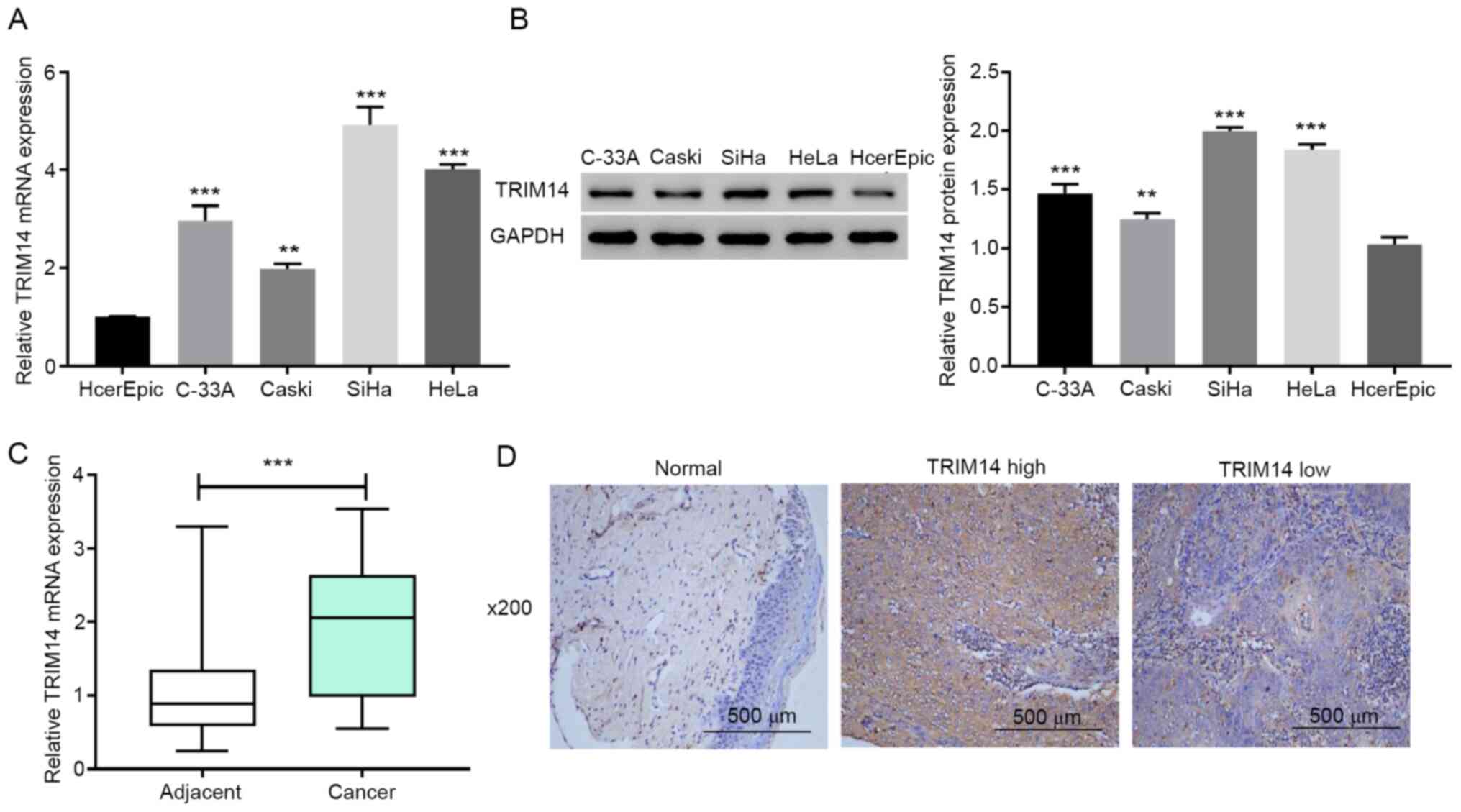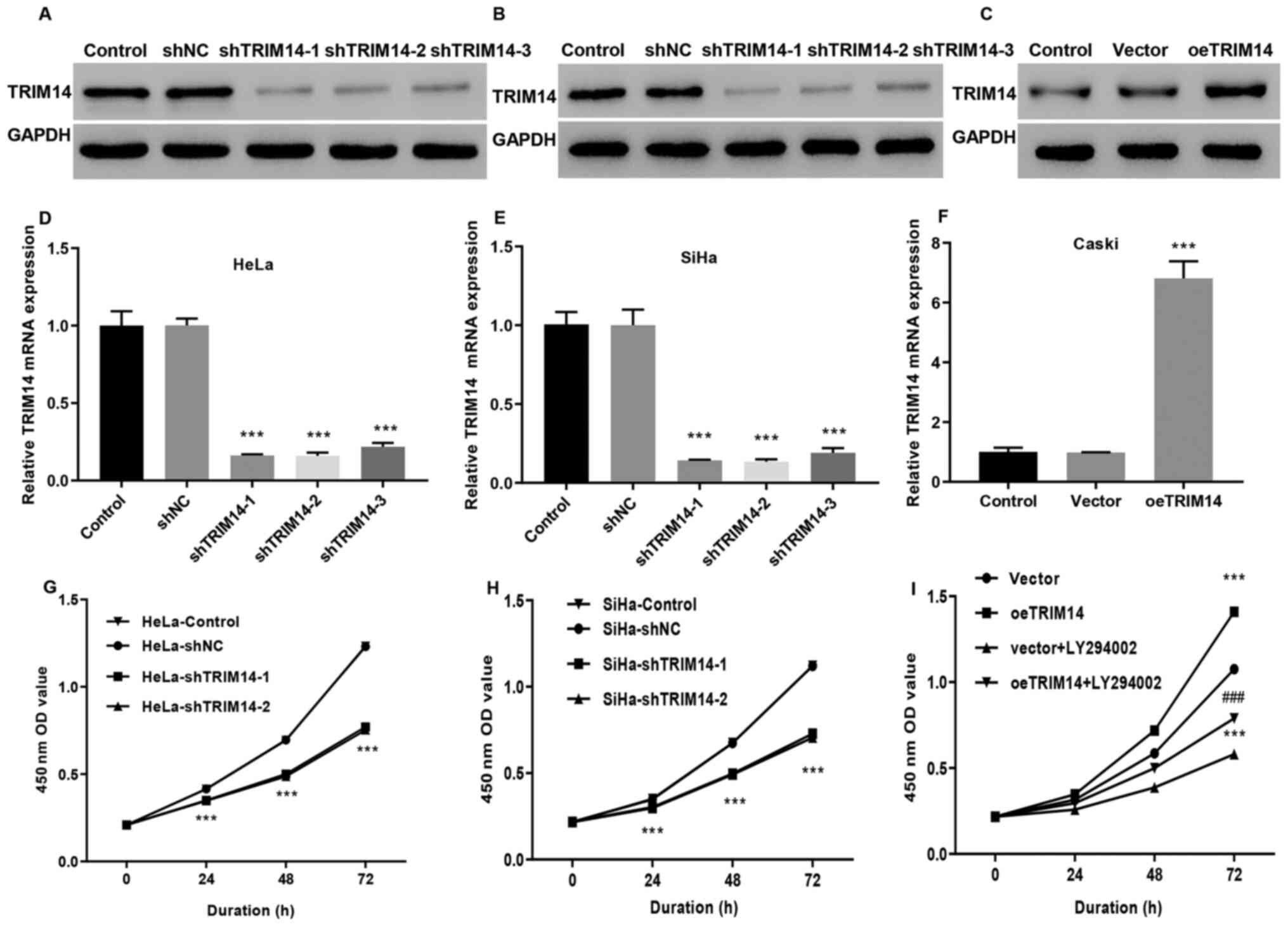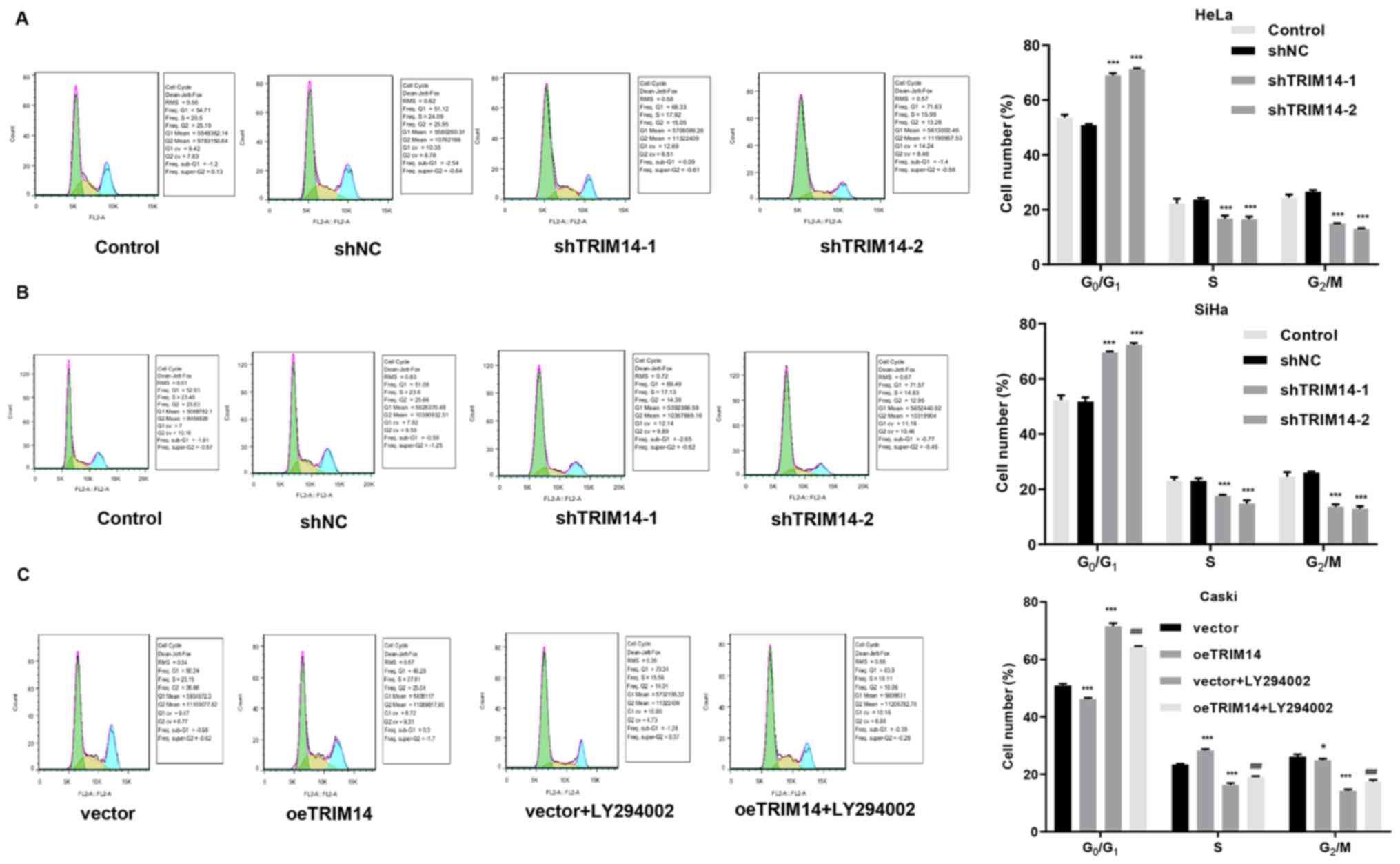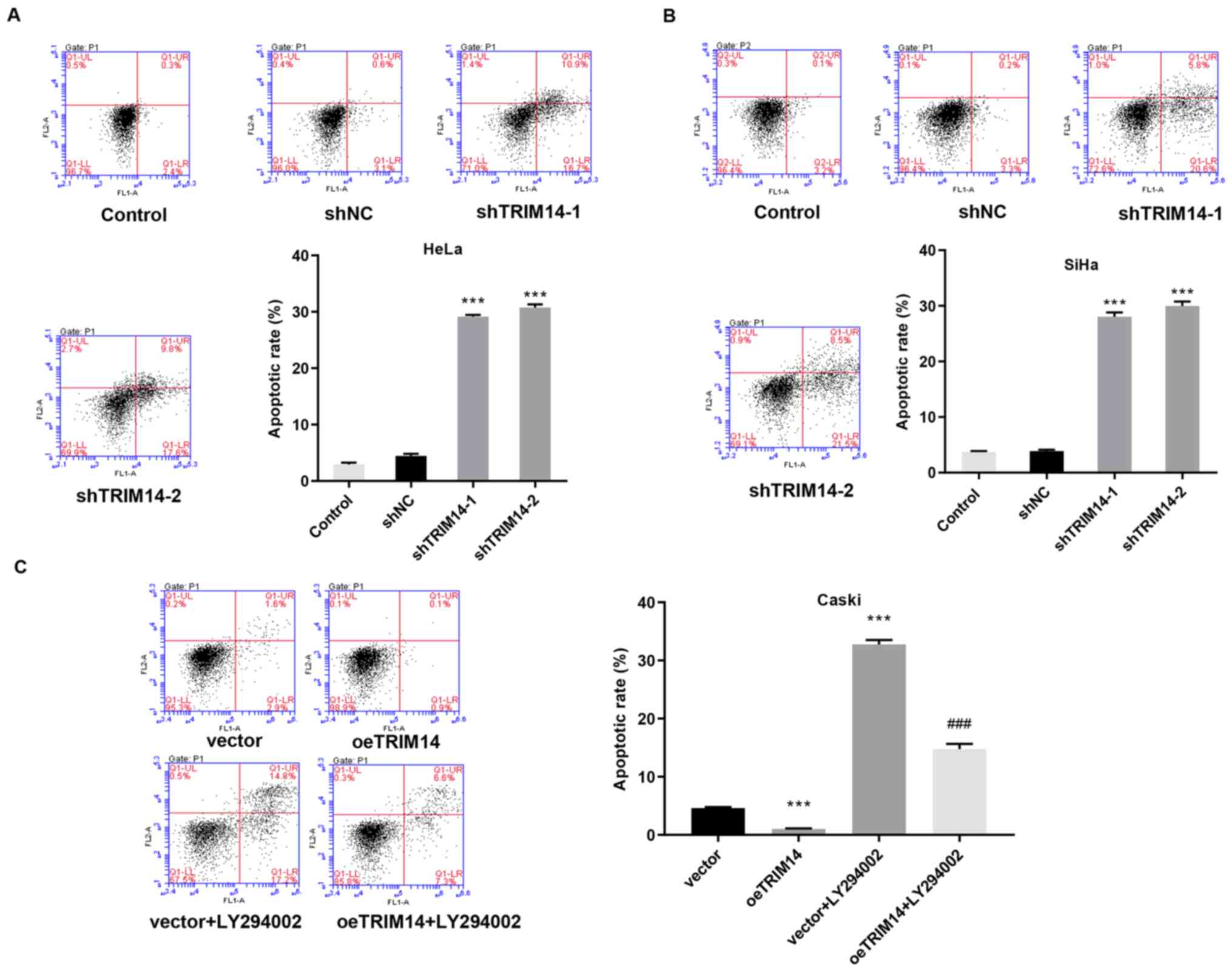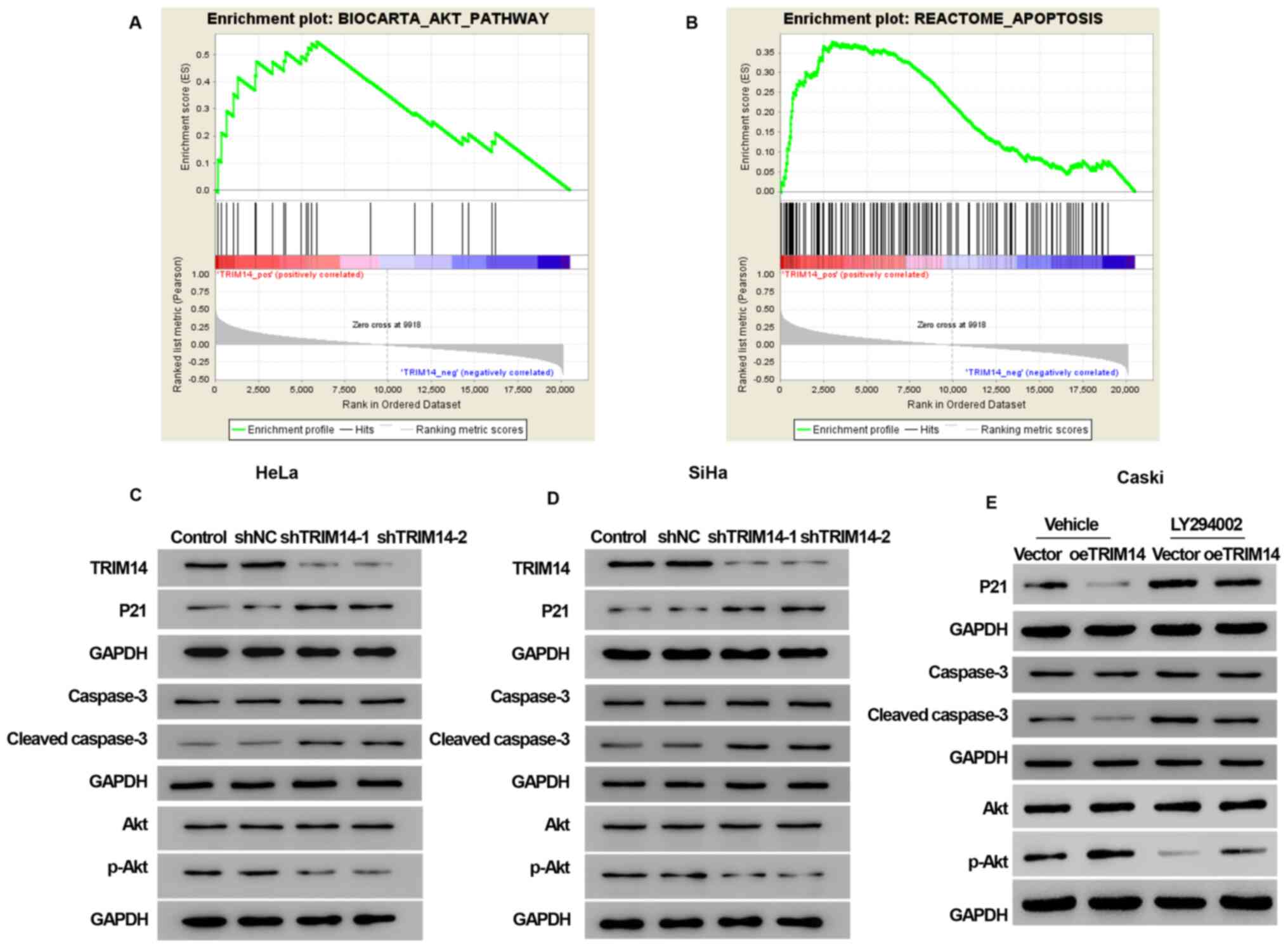|
1
|
Monsonego J: Prevention of cervical
cancer: Screening, progress and perspectives. Presse Med.
36:92–111. 2007.(In French). View Article : Google Scholar : PubMed/NCBI
|
|
2
|
Molinolo AA, Marsh C, El Dinali M, Gangane
N, Jennison K, Hewitt S, Patel V, Seiwert TY and Gutkind JS: mTOR
as a molecular target in HPV-associated oral and cervical squamous
carcinomas. Clin Cancer Res. 18:2558–2568. 2012. View Article : Google Scholar : PubMed/NCBI
|
|
3
|
Kim SH, Juhnn YS, Kang S, Park SW, Sung
MW, Bang YJ and Song YS: Human papillomavirus 16 E5 up-regulates
the expression of vascular endothelial growth factor through the
activation of epidermal growth factor receptor, MEK/ ERK1,2 and
PI3K/Akt. Cell Mol Life Sci. 63:930–938. 2006. View Article : Google Scholar : PubMed/NCBI
|
|
4
|
Oh K-J, Kalinina A, Park N-H and Bagchi S:
Deregulation of eIF4E: 4E-BP1 in differentiated human
papillomavirus-containing cells leads to high levels of expression
of the E7 oncoprotein. J Virol. 80:7079–7088. 2006. View Article : Google Scholar : PubMed/NCBI
|
|
5
|
Hatakeyama S: TRIM proteins and cancer.
Nat Rev Cancer. 11:792–804. 2011. View
Article : Google Scholar : PubMed/NCBI
|
|
6
|
Xu G, Guo Y, Xu D, Wang Y, Shen Y, Wang F,
Lv Y, Song F, Jiang D, Zhang Y, et al: TRIM14 regulates cell
proliferation and invasion in osteosarcoma via promotion of the AKT
signaling pathway. Sci Rep. 7:424112017. View Article : Google Scholar : PubMed/NCBI
|
|
7
|
Su X, Wang J, Chen W, Li Z, Fu X and Yang
A: Overexpression of TRIM14 promotes tongue squamous cell carcinoma
aggressiveness by activating the NF-κB signaling pathway.
Oncotarget. 7:9939–9950. 2016. View Article : Google Scholar : PubMed/NCBI
|
|
8
|
Dong B and Zhang W: High Levels of TRIM14
Are Associated with Poor Prognosis in Hepatocellular Carcinoma.
Oncol Res Treat. 41:129–134. 2018. View Article : Google Scholar : PubMed/NCBI
|
|
9
|
Zhou X, Dou M, Ding X, et al: Expressions
of EZH2 and DLC1 in breast cancer tissues and cell lines and their
correlation. Tumor. 37:856–864. 2017.
|
|
10
|
Livak KJ and Schmittgen TD: Analysis of
relative gene expression data using real-time quantitative PCR and
the 2(-Delta Delta C(T)) Method. Methods. 25:402–408. 2001.
View Article : Google Scholar : PubMed/NCBI
|
|
11
|
Colaprico A, Silva TC, Olsen C, Garofano
L, Cava C, Garolini D, Sabedot TS, Malta TM, Pagnotta SM,
Castiglioni I, et al: TCGAbiolinks: An R/Bioconductor package for
integrative analysis of TCGA data. Nucleic Acids Res. 44:e712016.
View Article : Google Scholar : PubMed/NCBI
|
|
12
|
Hassan M, Watari H, AbuAlmaaty A, Ohba Y
and Sakuragi N: Apoptosis and molecular targeting therapy in
cancer. BioMed Res Int. 2014:1508452014. View Article : Google Scholar : PubMed/NCBI
|
|
13
|
Zhang W, Zhou Q, Wei Y, Da M, Zhang C,
Zhong J, Liu J and Shen J: The exosome-mediated PI3k/Akt/mTOR
signaling pathway in cervical cancer. Int J Clin Exp Pathol.
12:2474–2484. 2019.PubMed/NCBI
|
|
14
|
Tateishi K, Nakamura T, Juratli TA,
Williams EA, Matsushita Y, Miyake S, Nishi M, Miller JJ, Tummala
SS, Fink AL, et al: PI3K/AKT/mTOR Pathway Alterations Promote
Malignant Progression and Xenograft Formation in Oligodendroglial
Tumors. Clin Cancer Res. 25:4375–4387. 2019. View Article : Google Scholar : PubMed/NCBI
|
|
15
|
Yue W, Wang X and Wang Y: The Relationship
between the PI3K/Akt/mTOR Signal Transduction Pathway and Non-small
Cell Lung Cancer. Zhongguo Fei Ai Za Zhi. 12:312–315. 2009.(In
Chinese). PubMed/NCBI
|
|
16
|
Zhou HY and Huang SL: Current development
of the second generation of mTOR inhibitors as anticancer agents.
Chin J Cancer. 31:8–18. 2012.PubMed/NCBI
|
|
17
|
Martelli AM, Evangelisti C, Chiarini F and
McCubrey JA: The phosphatidylinositol 3-kinase/Akt/mTOR signaling
network as a therapeutic target in acute myelogenous leukemia
patients. Oncotarget. 1:89–103. 2010. View Article : Google Scholar : PubMed/NCBI
|
|
18
|
Yao S, Xu J, Zhao K, Song P, Yan Q, Fan W,
Li W and Lu C: Down-regulation of HPGD by miR-146b-3p promotes
cervical cancer cell proliferation, migration and
anchorage-independent growth through activation of STAT3 and AKT
pathways. Cell Death Dis. 9:10552018. View Article : Google Scholar : PubMed/NCBI
|
|
19
|
Hu R, Wang MQ, Niu WB, Wang YJ, Liu YY,
Liu LY, Wang M, Zhong J, You HY, Wu XH, et al: SKA3 promotes cell
proliferation and migration in cervical cancer by activating the
PI3K/Akt signaling pathway. Cancer Cell Int. 18:1832018. View Article : Google Scholar : PubMed/NCBI
|
|
20
|
Wang T, Ren Y, Liu R, Ma J, Shi Y, Zhang L
and Bu R: miR-195-5p Suppresses the Proliferation, Migration, and
Invasion of Oral Squamous Cell Carcinoma by Targeting TRIM14.
Biomed Res Int. 2017:73781482017. View Article : Google Scholar : PubMed/NCBI
|
|
21
|
Kong L, Schäfer G, Bu H, Zhang Y, Zhang Y
and Klocker H: Lamin A/C protein is overexpressed in
tissue-invading prostate cancer and promotes prostate cancer cell
growth, migration and invasion through the PI3K/AKT/PTEN pathway.
Carcinogenesis. 33:751–759. 2012. View Article : Google Scholar : PubMed/NCBI
|
|
22
|
Wang X, Guo H, Yao B and Helms J: miR-15b
inhibits cancer-initiating cell phenotypes and chemoresistance of
cisplatin by targeting TRIM14 in oral tongue squamous cell cancer.
Oncol Rep. 37:2720–2726. 2017. View Article : Google Scholar : PubMed/NCBI
|
|
23
|
Wang Y, Lin Z, Sun L, Fan S, Huang Z,
Zhang D, Yang Z, Li J and Chen W: Akt/Ezrin Tyr353/NF-κB pathway
regulates EGF-induced EMT and metastasis in tongue squamous cell
carcinoma. Br J Cancer. 110:695–705. 2014. View Article : Google Scholar : PubMed/NCBI
|
|
24
|
Jin Z, Li H, Hong X, Ying G, Lu X, Zhuang
L and Wu S: TRIM14 promotes colorectal cancer cell migration and
invasion through the SPHK1/STAT3 pathway. Cancer Cell Int.
18:2022018. View Article : Google Scholar : PubMed/NCBI
|
|
25
|
Wang F, Ruan L, Yang J, Zhao Q and Wei W:
TRIM14 promotes the migration and invasion of gastric cancer by
regulating epithelial to mesenchymal transition via activation of
AKT signaling regulated by miR 195 5p. Oncol Rep. 40:3273–3284.
2018.PubMed/NCBI
|
|
26
|
Tsimberidou AM: Targeted therapy in
cancer. Cancer Chemother Pharmacol. 76:1113–1132. 2015. View Article : Google Scholar : PubMed/NCBI
|
|
27
|
Berberich A, Kessler T, Thomé CM, Pusch S,
Hielscher T, Sahm F, Oezen I, Schmitt LM, Ciprut S, Hucke N, et al:
Targeting Resistance against the MDM2 Inhibitor RG7388 in
Glioblastoma Cells by the MEK Inhibitor Trametinib. Clin Cancer
Res. 25:253–265. 2019. View Article : Google Scholar : PubMed/NCBI
|
|
28
|
Song H, Zhang J, Ning L, Zhang H, Chen D,
Jiao X and Zhang K: The MEK1/2 Inhibitor AZD6244 Sensitizes
BRAF-Mutant Thyroid Cancer to Vemurafenib. Med Sci Monit.
24:3002–3010. 2018. View Article : Google Scholar : PubMed/NCBI
|
|
29
|
Narayan RS, Fedrigo CA, Brands E, Dik R,
Stalpers LJ, Baumert BG, Slotman BJ, Westerman BA, Peters GJ and
Sminia P: The allosteric AKT inhibitor MK2206 shows a synergistic
interaction with chemotherapy and radiotherapy in glioblastoma
spheroid cultures. BMC Cancer. 17:2042017. View Article : Google Scholar : PubMed/NCBI
|
|
30
|
Lee CM, Fuhrman CB, Planelles V, Peltier
MR, Gaffney DK, Soisson AP, Dodson MK, Tolley HD, Green CL and
Zempolich KA: Phosphatidylinositol 3-kinase inhibition by LY294002
radiosensitizes human cervical cancer cell lines. Clin Cancer Res.
12:250–256. 2006. View Article : Google Scholar : PubMed/NCBI
|
|
31
|
Gupta AK, Cerniglia GJ, Mick R, Ahmed MS,
Bakanauskas VJ, Muschel RJ and McKenna WG: Radiation sensitization
of human cancer cells in vivo by inhibiting the activity of PI3K
using LY294002. Int J Radiat Oncol Biol Phys. 56:846–853. 2003.
View Article : Google Scholar : PubMed/NCBI
|
|
32
|
Marret H, Lhommé C, Lecuru F, Canis M,
Lévèque J, Golfier F and Morice P: Guidelines for the management of
ovarian cancer during pregnancy. Eur J Obstet Gynecol Reprod Biol.
149:18–21. 2010. View Article : Google Scholar : PubMed/NCBI
|
|
33
|
van Gent M, Sparrer KMJ and Gack MU: TRIM
Proteins and Their Roles in Antiviral Host Defenses. Annu Rev
Virol. 5:385–405. 2018. View Article : Google Scholar : PubMed/NCBI
|
|
34
|
Nenasheva VV, Kovaleva GV, Uryvaev LV,
Ionova KS, Dedova AV, Vorkunova GK, Chernyshenko SV, Khaidarova NV
and Tarantul VZ: Enhanced expression of trim14 gene suppressed
Sindbis virus reproduction and modulated the transcription of a
large number of genes of innate immunity. Immunol Res. 62:255–262.
2015. View Article : Google Scholar : PubMed/NCBI
|
|
35
|
Cohen D, Melamed S, Millman A, Shulman G,
Oppenheimer-Shaanan Y, Kacen A, Doron S, Amitai G and Sorek R:
Cyclic GMP-AMP signalling protects bacteria against viral
infection. Nature. 574:691–695. 2019. View Article : Google Scholar : PubMed/NCBI
|
|
36
|
Chen M, Meng Q, Qin Y, Liang P, Tan P, He
L, Zhou Y, Chen Y, Huang J, Wang RF, et al: TRIM14 Inhibits cGAS
Degradation Mediated by Selective Autophagy Receptor p62 to Promote
Innate Immune Responses. Mol Cell. 64:105–119. 2016. View Article : Google Scholar : PubMed/NCBI
|
|
37
|
Pańczyszyn A, Boniewska-Bernacka E and
Głąb G: Telomeres and Telomerase During Human
Papillomavirus-Induced Carcinogenesis. Mol Diagn Ther. 22:421–430.
2018. View Article : Google Scholar : PubMed/NCBI
|
|
38
|
Aimagambetova G and Azizan A: Epidemiology
of HPV Infection and HPV-Related Cancers in Kazakhstan: A Review.
Asian Pac J Cancer Prev. 19:1175–1180. 2018.PubMed/NCBI
|
|
39
|
Pecorelli S: Revised FIGO staging for
carcinoma of the vulva, cervix, and endometrium. Int J Gynaecol
Obstet. 105:103–104. 2009. View Article : Google Scholar : PubMed/NCBI
|















